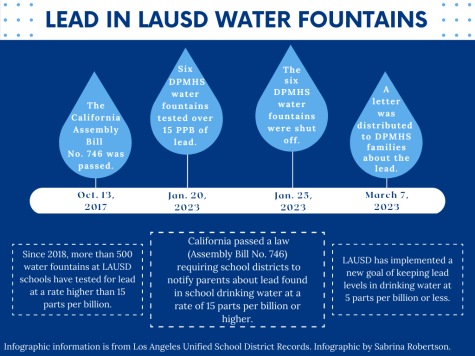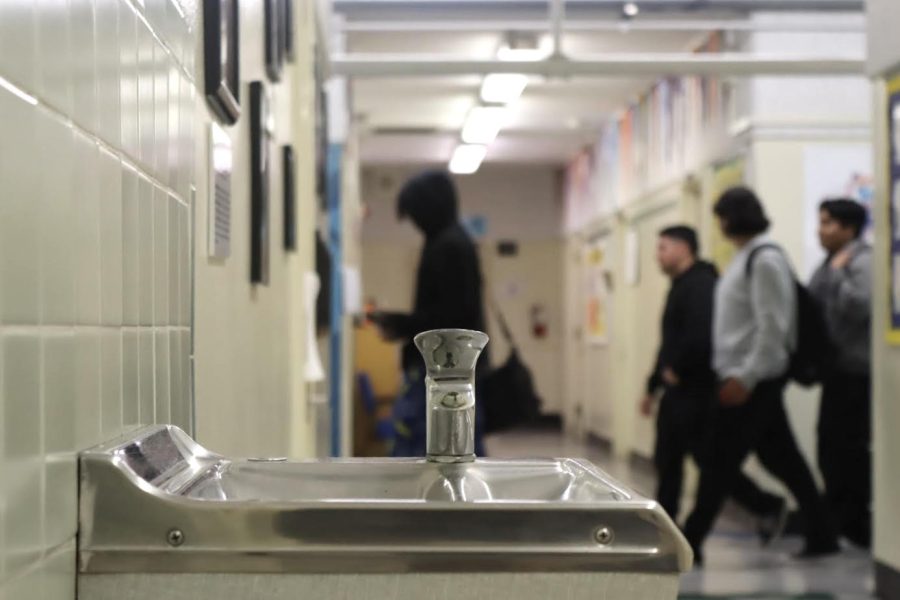Six water fountains from Daniel Pearl Magnet High School were shut down in January due to unsafe concentrations of lead. The Los Angeles Unified School District sent out a letter informing parents and students on March 7.
Six water fountains shut off due to high lead levels
The school sent out a letter letting students and parents know of the high lead levels in the water fountains on March 7, despite the school shutting them down more than a month ago.
March 20, 2023
Freshman Nemesi Morales uses the water fountains on a daily basis as her only source of water at school. Despite expressing concerns about lead concentrations in the school’s water, Morales will continue to drink from the fountains out of necessity.
“I can’t waste a dollar every day on a water bottle,” Morales said. “I can’t waste 10 to 15 dollars on an actual water bottle and refill it every day. It’s not something that’s in my budget.”
Morales’ concerns come after Daniel Pearl Magnet High School (DPMHS) shut down six water fountains containing high levels of lead in January. These fountains, many of which are located in the hallways, all had lead levels higher than the Centers for Disease Control’s (CDC) guideline of less than 15 parts per billion. Of the fountains that were shut off, the lead testing data ranged from 17.245 parts per billion to 65.3 parts per billion.
On March 7, more than a month after the lead testing was conducted, the Los Angeles Unified School District (LAUSD) sent out a letter to DPMHS families notifying them of the findings.
“I was surprised because I know so many people are carrying bottles of water with them all the time so I didn’t know how useful it was to have actual fountains,” Ronan Nakash, father of sophomore Leeron Nakash said. “But people use them, so it’s definitely a good thing that they test them occasionally.”
In 2017, California passed a law requiring school districts to notify parents about lead found in school drinking water at a rate of 15 parts per billion or higher. LAUSD records show that DPMHS tested school water fountains and found high lead levels on Jan. 20. Yet the school did not shut off those water fountains until Jan. 25—and didn’t notify the DPMHS community until it sent out the March 7 letter.
“In addition to any remediation efforts, the school will also notify the school community when a water fixture does not meet the District’s stringent health requirements, outlining immediate measures that are taken to safeguard the health and safety of our students and our staff,” an LAUSD spokesperson said in a statement to The Pearl Post. “This notification is sent once a thorough investigation has concluded with all the appropriate remediation efforts.”
Despite complaints about the school water tasting metallic, students frequently used the water fountains throughout the school day to keep themselves hydrated. Morales drinks from the fountains to prevent dizziness after exercising in PE.
Children are more susceptible to lead poisoning because their brains and bodies are still developing. According to the World Health Organization, high levels of lead exposure affect the central and nervous systems, harming brain development and altering behavior such as by shortening attention span. Lead concentrations between 5 ppb and 15 ppb pose a health risk and concentrations above 15 ppb present a more serious hazard that requires schools to shut off affected water fountains and notify the school community.
With the news about the water’s high lead concentrations, some students said they are more cautious when drinking from the school water fountains.
“I would like more news on it before I use them at school again just to know that it’s more safe,” senior Jessie Witt said.
Others have decided to gradually stop drinking from all the school’s water fountains from now on. Although lead levels are not considered unsafe in the water fountains that remain operational, reports have still identified small levels of lead in their water.
“I’m not using them ever (again),” junior Khalel Gillen said. “I’m beginning to use the ones that I used to use frequently less and less because apparently to the letter, they still had a little bit of lead in them, which is concerning to say the least.”

According to LAUSD records obtained by The Pearl Post, more than 500 water fountains at district schools have tested for lead at a rate higher than 15 parts per billion since 2018. Some LAUSD high schools, especially those with older buildings or antiquated fixtures, had more than 10 water fountains with results above the safe level.
“Los Angeles Unified takes the safety of our students very seriously,” the LAUSD spokesperson said. “As part of this commitment, we have adopted stringent health requirements for our drinking water that exceed state and national requirements.”
According to the March 7 letter, LAUSD is instituting a new lead in drinking water goal of 5 parts per billion or less.
“Los Angeles Unified has recently completed another round of comprehensive water testing and is taking action to reduce and maintain the level of lead in all school drinking water to below 5 parts per billion,” the spokesperson said. “[This is] one of the strictest requirements in the nation for a school district.”
The updated requirement stems from LAUSD’s goal of addressing student safety, which comes as a comfort to some.
“It’s reassuring that they’re doing their best to look out for people’s health and safety,” Witt said.
Gillen suggests making jugs of filtered water available with disposable plastic cups. According to Morales, the district should make lead testing in pipes a more frequent practice. Going forward, the DPMHS administration will decide how best to ensure that water from all the water fountains is safe again.
Principal Armen Petrossian declined an interview about the school’s plans to address the issue of the shut off water fountains. It is unclear if the pipes will be replaced or if they will be removed.
“It’s sad that they create some (new) standard only when they discovered there was a problem, (but) I’m happy about finding (the unhealthy lead concentrations),” Nakash said. “If there is scientific data that the water is unhealthy, then of course I am happy about this.”

